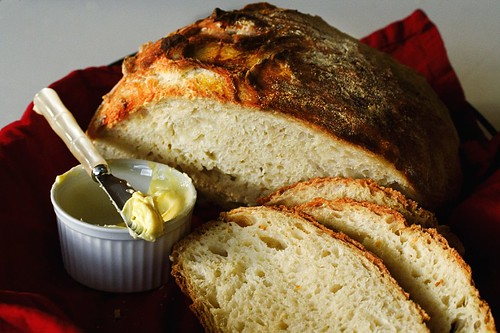給leela同學加把油!這個麵包我也做過,真的是超簡單超好吃。:)大家看圖說話吧。
網上最詳細的方法來自於steamy kitchen.
我很不厚道的把圖片拷過來了。。聲明一下,這隻是給自己留一個記錄,著作權是別人的。
“如此的簡單。。四歲的孩子都可以做哦!“
http://steamykitchen.com/168-no-knead-bread-revisited.html
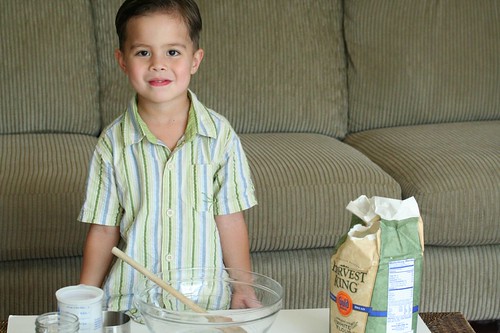
3杯麵粉
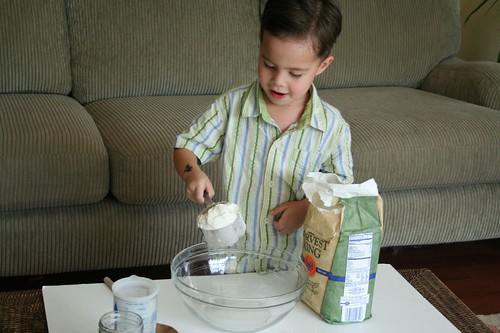
1/4 小勺酵母粉
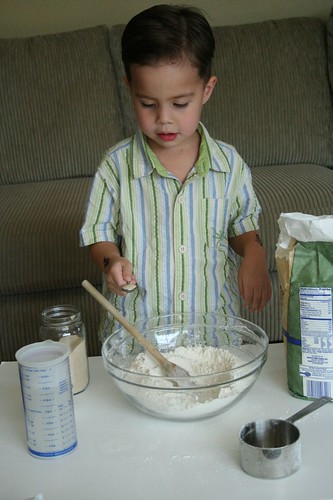
1小勺鹽(用海鹽味道更好!因為海鹽粗,酌情增加用量,因為1小勺是細鹽的體積)

1.5杯溫水
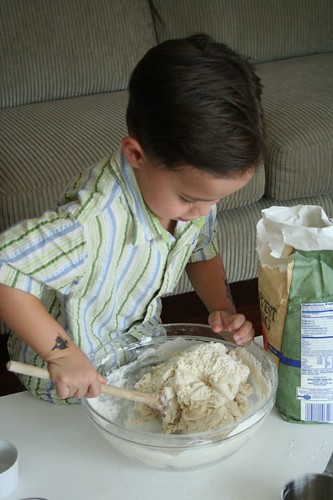
麵團會很濕

不用揉,蓋起來

明天見!
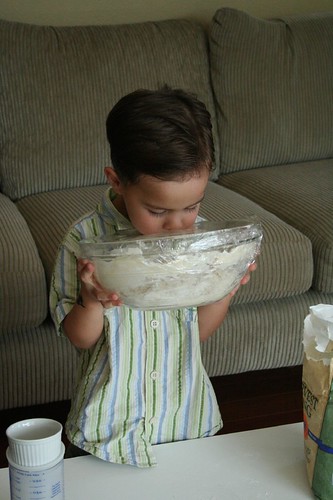
12小時後。。。
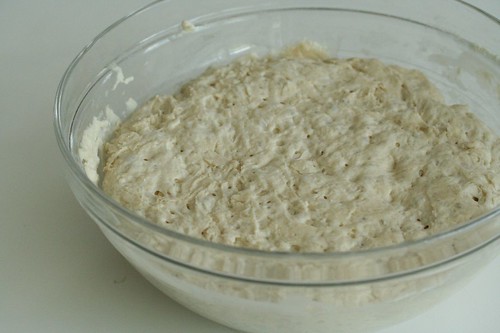
扔在灑了麵粉的案板上

輕輕捏成團,蓋好,再發酵2小時

把一個很厚重的大鍋450華氏度預熱30分鍾,然後把麵團丟進去,蓋上蓋,烤30分鍾,然後揭開蓋子,烤15-20分鍾。
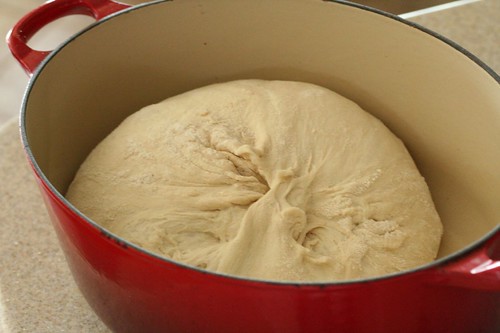
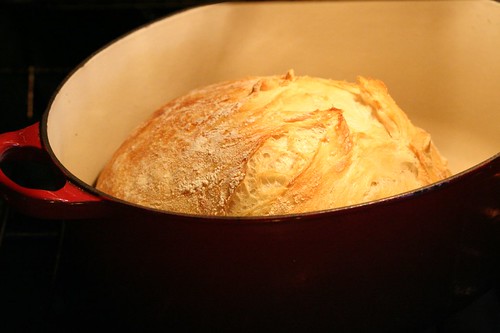
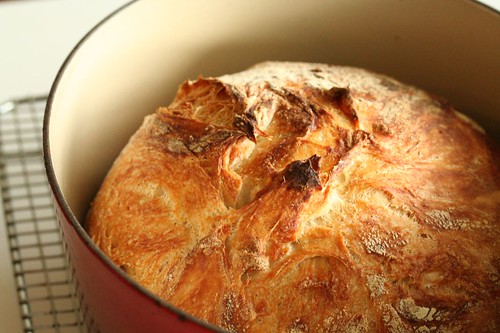
拿出來,在架子上冷卻
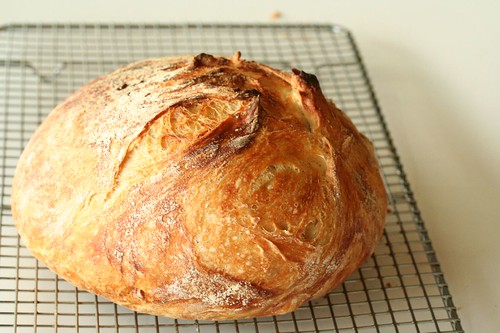
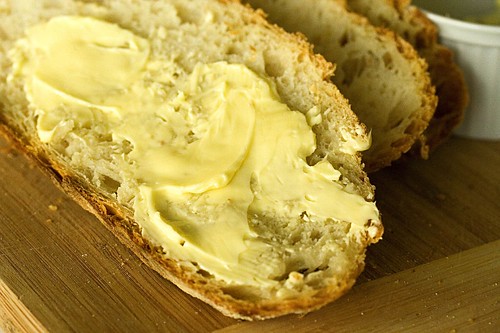
原理:
為什麽專業的歐式麵包,麵皮薄脆,咬之掉渣,芯裏卻軟軟?秘訣就是用sourdough starter,然後在蒸汽烤箱裏烤。家庭烤箱沒有這個條件,所以往往烤出的麵包的皮硬得像石頭。sourdough starter自己可以做,但是很麻煩,需要每天伺候著,如果不是天天做麵包,還要扔掉不少,浪費極了。
這個麵包用慢發酵的方法產生sourdough的味道,麵團很濕,麵筋的蛋白分子更容易遊來遊去結合成綿軟的絲,長時間發酵會出現固定的孔洞,讓麵包芯有嚼頭。高濕度在大鍋裏產生很多蒸汽,大鍋蓋上蓋子,就好像一個蒸汽小烤箱,能夠產生專業蒸汽烤箱的脆皮效果。理解了原理,就明白,這的確是革命性的好點子!
紐約時報的專欄,值得一讀
--好麵包的訣竅:讓時間來做工
The Secret of Great Bread: Let Time Do the Work
INNOVATIONS in bread baking are rare. In fact, the 6,000-year-old process hasn’t changed much since Pasteur made the commercial production of standardized yeast possible in 1859. The introduction of the gas stove, the electric mixer and the food processor made the process easier, faster and more reliable.
I’m not counting sliced bread as a positive step, but Jim Lahey’s method may be the greatest thing since.
This story began in late September when Mr. Lahey sent an e-mail message inviting me to attend a session of a class he was giving at Sullivan Street Bakery, which he owns, at 533 West 47th Street in Manhattan. His wording was irresistible: “I’ll be teaching a truly minimalist breadmaking technique that allows people to make excellent bread at home with very little effort. The method is surprisingly simple — I think a 4-year-old could master it — and the results are fantastic.”
I set up a time to visit Mr. Lahey, and we baked together, and the only bad news is that you cannot put your 4-year-old to work producing bread for you. The method is complicated enough that you would need a very ambitious 8-year-old. But the results are indeed fantastic.
Mr. Lahey’s method is striking on several levels. It requires no kneading. (Repeat: none.) It uses no special ingredients, equipment or techniques. It takes very little effort.
It accomplishes all of this by combining a number of unusual though not unheard of features. Most notable is that you’ll need about 24 hours to create a loaf; time does almost all the work. Mr. Lahey’s dough uses very little yeast, a quarter teaspoon (you almost never see a recipe with less than a teaspoon), and he compensates for this tiny amount by fermenting the dough very slowly. He mixes a very wet dough, about 42 percent water, which is at the extreme high end of the range that professional bakers use to create crisp crust and large, well-structured crumb, both of which are evident in this loaf.
The dough is so sticky that you couldn’t knead it if you wanted to. It is mixed in less than a minute, then sits in a covered bowl, undisturbed, for about 18 hours. It is then turned out onto a board for 15 minutes, quickly shaped (I mean in 30 seconds), and allowed to rise again, for a couple of hours. Then it’s baked. That’s it.
I asked Harold McGee, who is an amateur breadmaker and best known as the author of “On Food and Cooking” (Scribner, 2004), what he thought of this method. His response: “It makes sense. The long, slow rise does over hours what intensive kneading does in minutes: it brings the gluten molecules into side-by-side alignment to maximize their opportunity to bind to each other and produce a strong, elastic network. The wetness of the dough is an important piece of this because the gluten molecules are more mobile in a high proportion of water, and so can move into alignment easier and faster than if the dough were stiff.”
That’s as technical an explanation as I care to have, enough to validate what I already knew: Mr. Lahey’s method is creative and smart.
But until this point, it’s not revolutionary. Mr. McGee said he had been kneading less and less as the years have gone by, relying on time to do the work for him. Charles Van Over, author of the authoritative book on food-processor dough making, “The Best Bread Ever” (Broadway, 1997), long ago taught me to make a very wet dough (the food processor is great at this) and let it rise slowly. And, as Mr. Lahey himself notes, “The Egyptians mixed their batches of dough with a hoe.”
What makes Mr. Lahey’s process revolutionary is the resulting combination of great crumb, lightness, incredible flavor — long fermentation gives you that — and an enviable, crackling crust, the feature of bread that most frequently separates the amateurs from the pros. My bread has often had thick, hard crusts, not at all bad, but not the kind that shatter when you bite into them. Producing those has been a bane of the amateur for years, because it requires getting moisture onto the bread as the crust develops.
To get that kind of a crust, professionals use steam-injected ovens. At home I have tried brushing the dough with water (a hassle and ineffective); spraying it (almost as ineffective and requiring frequent attention); throwing ice cubes on the floor of the oven (not good for the oven, and not far from ineffective); and filling a pot with stones and preheating it, then pouring boiling water over the stones to create a wet sauna (quite effective but dangerous, physically challenging and space-consuming). I was discouraged from using La Cloche, a covered stoneware dish, by my long-standing disinclination to crowd my kitchen with inessential items that accomplish only one chore. I was discouraged from buying a $5,000 steam-injected oven by its price.
It turns out there’s no need for any of this. Mr. Lahey solves the problem by putting the dough in a preheated covered pot — a common one, a heavy one, but nothing fancy. For one loaf he used an old Le Creuset enameled cast iron pot; for another, a heavy ceramic pot. (I have used cast iron with great success.) By starting this very wet dough in a hot, covered pot, Mr. Lahey lets the crust develop in a moist, enclosed environment. The pot is in effect the oven, and that oven has plenty of steam in it. Once uncovered, a half-hour later, the crust has time to harden and brown, still in the pot, and the bread is done. (Fear not. The dough does not stick to the pot any more than it would to a preheated bread stone.)
The entire process is incredibly simple, and, in the three weeks I’ve been using it, absolutely reliable. Though professional bakers work with consistent flour, water, yeast and temperatures, and measure by weight, we amateurs have mostly inconsistent ingredients and measure by volume, which can make things unpredictable. Mr. Lahey thinks imprecision isn’t much of a handicap and, indeed, his method seems to iron out the wrinkles: “I encourage a somewhat careless approach,” he says, “and figure this may even be a disappointment to those who expect something more difficult. The proof is in the loaf.”
The loaf is incredible, a fine-bakery quality, European-style boule that is produced more easily than by any other technique I’ve used, and will blow your mind. (It may yet change the industry. Mr. Lahey is experimenting with using it on a large scale, but although it requires far less electricity than conventional baking, it takes a lot of space and time.) It is best made with bread flour, but all-purpose flour works fine. (I’ve played with whole-wheat and rye flours, too; the results are fantastic.)
You or your 8-year-old may hit this perfectly on the first try, or you may not. Judgment is involved; with practice you’ll get it right every time.
The baking itself is virtually foolproof, so the most important aspect is patience. Long, slow fermentation is critical. Mr. Lahey puts the time at 12 to 18 hours, but I have had much greater success at the longer time. If you are in a hurry, more yeast (three-eighths of a teaspoon) or a warmer room temperature may move things along, but really, once you’re waiting 12 hours why not wait 18? Similarly, Mr. Lahey’s second rising can take as little as an hour, but two hours, or even a little longer, works better.
Although even my “failed” loaves were as good as those from most bakeries, to make the loaf really sensational requires a bit of a commitment. But with just a little patience, you will be rewarded with the best no-work bread you have ever made. And that’s no small thing.




